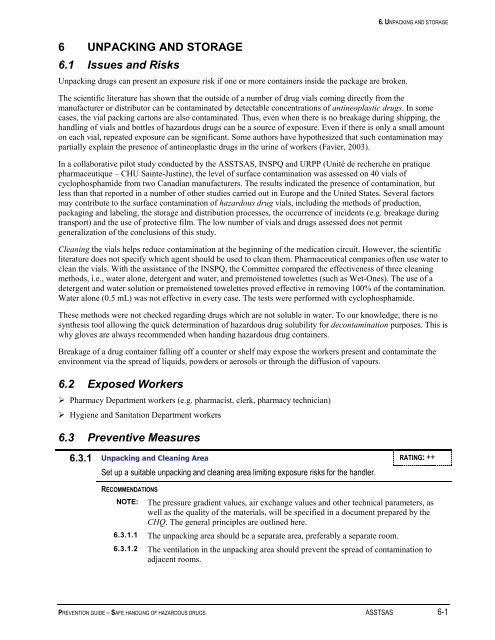Prevention Guide - Safe Handling of Hazardous Drugs - Irsst
Prevention Guide - Safe Handling of Hazardous Drugs - Irsst
Prevention Guide - Safe Handling of Hazardous Drugs - Irsst
You also want an ePaper? Increase the reach of your titles
YUMPU automatically turns print PDFs into web optimized ePapers that Google loves.
6. UNPACKING AND STORAGE<br />
6 UNPACKING AND STORAGE<br />
6.1 Issues and Risks<br />
Unpacking drugs can present an exposure risk if one or more containers inside the package are broken.<br />
The scientific literature has shown that the outside <strong>of</strong> a number <strong>of</strong> drug vials coming directly from the<br />
manufacturer or distributor can be contaminated by detectable concentrations <strong>of</strong> antineoplastic drugs. In some<br />
cases, the vial packing cartons are also contaminated. Thus, even when there is no breakage during shipping, the<br />
handling <strong>of</strong> vials and bottles <strong>of</strong> hazardous drugs can be a source <strong>of</strong> exposure. Even if there is only a small amount<br />
on each vial, repeated exposure can be significant. Some authors have hypothesized that such contamination may<br />
partially explain the presence <strong>of</strong> antineoplastic drugs in the urine <strong>of</strong> workers (Favier, 2003).<br />
In a collaborative pilot study conducted by the ASSTSAS, INSPQ and URPP (Unité de recherche en pratique<br />
pharmaceutique – CHU Sainte-Justine), the level <strong>of</strong> surface contamination was assessed on 40 vials <strong>of</strong><br />
cyclophosphamide from two Canadian manufacturers. The results indicated the presence <strong>of</strong> contamination, but<br />
less than that reported in a number <strong>of</strong> other studies carried out in Europe and the United States. Several factors<br />
may contribute to the surface contamination <strong>of</strong> hazardous drug vials, including the methods <strong>of</strong> production,<br />
packaging and labeling, the storage and distribution processes, the occurrence <strong>of</strong> incidents (e.g. breakage during<br />
transport) and the use <strong>of</strong> protective film. The low number <strong>of</strong> vials and drugs assessed does not permit<br />
generalization <strong>of</strong> the conclusions <strong>of</strong> this study.<br />
Cleaning the vials helps reduce contamination at the beginning <strong>of</strong> the medication circuit. However, the scientific<br />
literature does not specify which agent should be used to clean them. Pharmaceutical companies <strong>of</strong>ten use water to<br />
clean the vials. With the assistance <strong>of</strong> the INSPQ, the Committee compared the effectiveness <strong>of</strong> three cleaning<br />
methods, i.e., water alone, detergent and water, and premoistened towelettes (such as Wet-Ones). The use <strong>of</strong> a<br />
detergent and water solution or premoistened towelettes proved effective in removing 100% <strong>of</strong> the contamination.<br />
Water alone (0.5 mL) was not effective in every case. The tests were performed with cyclophosphamide.<br />
These methods were not checked regarding drugs which are not soluble in water. To our knowledge, there is no<br />
synthesis tool allowing the quick determination <strong>of</strong> hazardous drug solubility for decontamination purposes. This is<br />
why gloves are always recommended when handing hazardous drug containers.<br />
Breakage <strong>of</strong> a drug container falling <strong>of</strong>f a counter or shelf may expose the workers present and contaminate the<br />
environment via the spread <strong>of</strong> liquids, powders or aerosols or through the diffusion <strong>of</strong> vapours.<br />
6.2 Exposed Workers<br />
‣ Pharmacy Department workers (e.g. pharmacist, clerk, pharmacy technician)<br />
‣ Hygiene and Sanitation Department workers<br />
6.3 Preventive Measures<br />
6.3.1 Unpacking and Cleaning Area RATING: ++<br />
Set up a suitable unpacking and cleaning area limiting exposure risks for the handler.<br />
RECOMMENDATIONS<br />
NOTE:<br />
The pressure gradient values, air exchange values and other technical parameters, as<br />
well as the quality <strong>of</strong> the materials, will be specified in a document prepared by the<br />
CHQ. The general principles are outlined here.<br />
6.3.1.1 The unpacking area should be a separate area, preferably a separate room.<br />
6.3.1.2 The ventilation in the unpacking area should prevent the spread <strong>of</strong> contamination to<br />
adjacent rooms.<br />
PREVENTION GUIDE – SAFE HANDLING OF HAZARDOUS DRUGS ASSTSAS 6-1

















